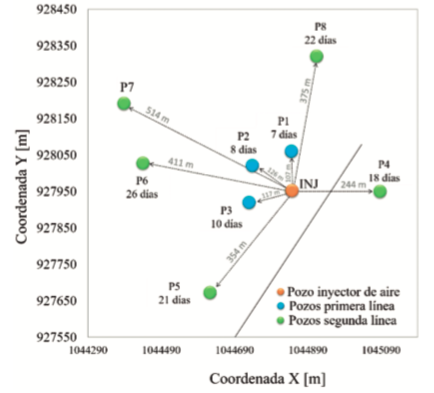Reducing uncertainty at the Chichimene in situ combustion pilot by means of a nitrogen connectivity test

Published 2018-12-20
Keywords
- Extra-heavy oil; Connectivity test; Nitrogen injection; Air injection; Enhanced Oil Recovery.
How to Cite
Copyright (c) 2018 Revista Fuentes

This work is licensed under a Creative Commons Attribution 4.0 International License.
Abstract
Prior to start any Enhanced Oil Recovery (EOR) process, it is desirable to characterize the flow pattern within the affected reservoir volume. This becomes of critical importance for in situ combustion in heavy oil reservoirs, where the mobility ratio is highly unfavorable, oftentimes resulting in channeling or early breakthrough. An inter-well connectivity test through immiscible gas injection aids improving the characterization of the flow distribution, in addition to: 1) calibrating estimates for sweep efficiency; 2) evidencing geological features that may lead to preferential flow towards a particular well or group of them, or lack of connection amongst them; 3) creating a gas path between the injector and producer wells to enable a safe progression of the combustion front; and 4) evaluating the performance of artificial lift and well control systems under high gas-liquid ratio conditions. A connectivity test using nitrogen was designed, implemented and evaluated at the Chichimene field, prior to the ignition of the in situ combustion pilot. This process is summarized and described in this paper. This will be the first in situ combustion trial in a deep (≈ 8000 ft.), extra-heavy oil reservoir, and will serve as a data source to evaluate the development of resources under similar conditions in the eastern plains basin of Colombia. This set of reservoirs bears a significant fraction of the hydrocarbon resources in the country and under Ecopetrol operation. The importance of this pilot makes this connectivity test of even larger relevance to reduce the subsurface and operational uncertainty, identifying potential risks, and increase the probability of success of the combustion process as an option to economically produce these resources.
Downloads
References
Bottia-Ramirez, H., Aguillon-Macea, M., Lizcano- Rubio, H., Delgadillo-Aya, C. L., & Gadelle, C. (2017). Numerical modeling on in-situ combustion process in the Chichimene field: Ignition stage. Journal of Petroleum Science and Engineering, 154, 462-468.
Burger, J. G. (1972). Chemical aspects of in-situ combustion-heat of combustion and kinetics. Society of Petroleum Engineers Journal, 12(05), 410-422.
Castañeda, A. M., Ruiz, M. C. & Navarro, S. F. (2014). Modelado de procesos de combustión in situ. Fuentes: El reventón energético, 12(1), 5.
Fassihi, M. R.; Brigham, W.; Ramey. Reaction Kinetics of in-situ combustion: Part 1-Observations. Paper SPE 8907. Agosto, 1984.
Glandt, C. A., Pieterson, R., Dombrowski, A., & Balzarini, M. A. (1999, January). Coral creek field study: a comprehensive assessment of the potential of high-pressure air injection in a mature waterflood project. In SPE mid- continent operations symposium. Society of Petroleum Engineers.
Hutchinson, H. L., Spivak, A., & Johnson, L. A. (1979, January). Simulation Study Of The LETC TS- 2C In Situ Combustion Test In Utah Tar Sands. In SPE Annual Technical Conference and Exhibition. Society of Petroleum Engineers.
Johnson Jr, L. A., Fahy, L. J., Romanowski, L. J., Barbour, R. V., & Thomas, K. P. (1980). An echoing in-situ combustion oil recovery project in a Utah tar sand. Journal of Petroleum Technology, 32(02), 295-305.
Moore, R.G. Mehta, S.A. and Ursenbach, M.G. A Guide to High-Pressure Air Injection (HPAI) Based Oil Recovery. Paper SPE 75207, presented at the SPE/DOE Improved Oil Recovery Symposium, Tulsa, OK, U.S.A., April 2002.
Navarro, W., Muñoz, S. F., Ordoñez, A. & Bottia, H (2016). Ajuste de una prueba de tubo de combustión usando un modelo simplificado de reacciones. Revista Fuentes, 14(2), 99-109.
Pebdani, F. N., Longoria, R., Wilkerson, D. N., & Venkatesan, V. N. (1988, January). Enhanced Oil Recovery by Wet In-Situ Oxygen Combustion: Esperson Dome Field, Liberty County, Texas. In SPE Annual Technical Conference and Exhibition. Society of Petroleum Engineers.
Reyes, J. P., Trujillo, M. L., Velásquez, E. N., & Aya, C. L. D. (2017). Metodología para la selección y priorización de yacimientos de crudo liviano candidatos a la inyección de aire: caso de aplicación. Fuentes: El reventón energético, 15(1), 41-48.
Sarathi, P. S. In-situ combustion handbook-principles and practices. Final Report, November 1998. Performed Under Contract No. DE-AC22- 94PC91008.
Turta, A. T., & Singhal, A. K. (2001). Reservoir engineering aspects of light-oil recovery by air injection. SPE Reservoir Evaluation & Engineering, 4(04), 336-344.